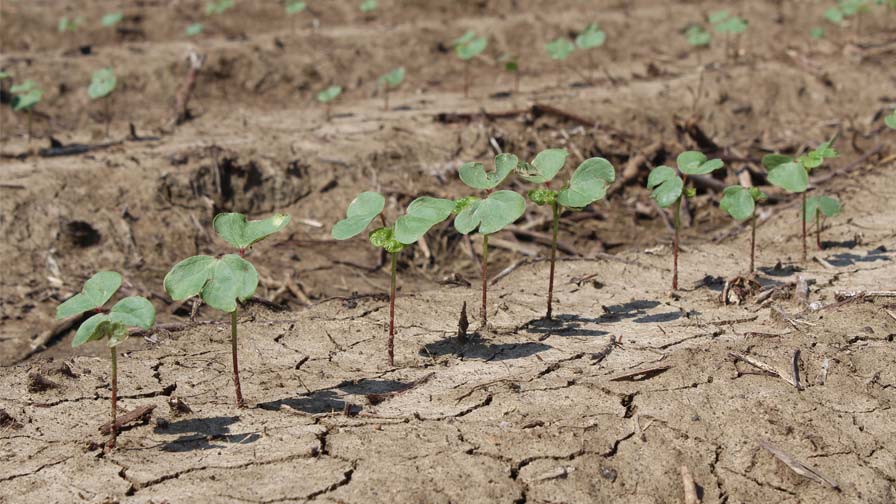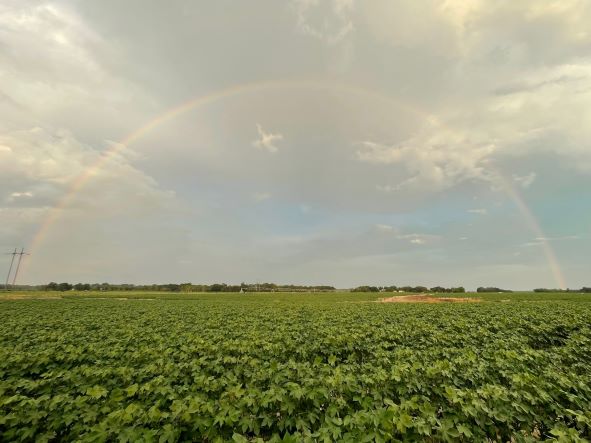Crop Scan Ag Report: Dryland Acres Done, Here Come the Bugs
To risk sounding like a broken record, it’s still mostly hot and dry across the Cotton Belt. Dryland acres range from being in serious trouble to kaput. Rain has helped in the Southeast, but irrigation is going to be the key to making a crop in most other areas. Insect pressure continues to grow. Here’s what consultants told us in mid-July.
Chad Harrell owns and operates Harrell Agronomic Services in Northeastern North Carolina.
Cotton in our region has progressed a lot since the last update. The earlier planted cotton is now approaching the third week of bloom while the later cotton is just beginning to bloom. Plant bug pressure picked up this week in the more attractive fields that have received rain, but they still remain spotty in most areas.
For the most part, we have just been really dry in our area until last week. The dryland cotton has received very little PGR as it is beginning to bloom higher up the plant. We have even had to treat a few fields for spider mites.
Most areas received a couple inches of rain over the last week which has really turned the cotton around. We will be making aggressive PGR applications on the late planted cotton this week.
Wes Briggs consults on cotton, corn, peanuts, soybeans, and small grains for growers in Georgia, Alabama, and Florida.
Cotton ranges from 4.5 weeks bloom (92 days) to only 12 days out of the ground. We have a wide range. Dry conditions the last two weeks allowed for lots of weed work. Herbicides have worked well this year, except for lack of grass control when mixing Roundup + XtendiMax/Engenia. Goosegrass escapes have been a big problem.
This week, many areas received much needed rainfall, anywhere from .5” to 5” in places. I’ve heard as much as 7” to 8” in neighboring counties. Our irrigated cotton is loaded up well, and we’re just beginning to see some fruit shed this week. Rain this week saved a lot of dryland acres from blooming out the top. Several fields were approaching 3-5 NAWF. Dryland cotton is by no means where it needs to be, and we will need several more rains to make decent yields. Most of our cotton we check is irrigated. We have limited dryland acres with good stands.
To date, insect pressure has been sporadic. Plant bug movement into cotton has been low, and we are seeing more stinkbugs in pre-bloom cotton. I expect stinkbugs will be our primary pest moving forward based off movement we’re seeing in other crops. Spider mites are in several fields and are starting to build. Hopefully recent rains will delay mite movement somewhat.
Target spot, to date, is not a concern. It takes heat + rainfall to drive this disease, and we definitely have both.
The major concern lately is the price of cotton falling from previous highs. With the increased cost of fertilizer, chemicals, and fuel, the cost of production has skyrocketed. 2022 very well may be the most expensive cotton crop in my 35+ years.
Surely there’s a pot of gold somewhere in this picture!
Photo: Wes Briggs
Tucker Miller is a Mississippi-based independent private consultant for cotton, soybeans, corn, peanuts, rice, and vegetables.
Our oldest cotton is in the third week of bloom and the youngest is just starting to bloom. We have been very dry in most areas and are irrigating constantly. Pivots have been around several times, and we are starting on our third time for row watering. We don’t have many dryland acres but, where we do, the cotton is getting a very high bloom in it.
We are currently under a bollworm moth flight and are getting a 20% to 30% egg lay in our irrigated cotton. We are treating our Bollgard II acres in the next few days. We will monitor the Bollgard 3 and hopefully will have no issues. Our plant bugs have been normal, and we are starting to get a big hatch out of nymphs. A good, general rain would be a big help.
Cotton blooming out the top outside the pivot (Tucker Miller)
Mark Nemec is an independent agricultural consultant for cotton, wheat, grain sorghum and corn in the Blacklands and Brazos River Bottom area of Central Texas.
It’s pretty quiet here in Central Texas. The only real noise around is all the irrigation equipment humming along in the Brazos Bottoms. It’s been too hot for much else.
We have been breaking high temperature records on a regular basis around here for the last several weeks. Temps of 103 to 108 degrees are common with some over that on occasion. We had a high of 111 degrees last weekend in College Station. Throw in a little humidity, and it is just plain miserable. Night time temperatures are staying around 80 degrees or higher.
With this early heat wave, our dryland cotton is kaput. It has thrown off most, if not all, the squares and blooms. We started seeing some open several weeks ago. Yields are not going to be very good on most fields. Irrigated cotton is doing okay. We’ve been trying to keep it from cutting out too soon. If there is a hiccup with the equipment, the blooms start racing to the top.
Kerry Siders is Texas A&M AgriLife Extension Agent-IPM for Hockley, Cochran, and Lamb Counties.
The Southern High Plains of Texas has begun to settle in with very little dryland cotton acres remaining and only about half of the irrigated acres left to tend to. The most advanced cotton has been blooming since a few days prior to July 4.
For a great majority of acres, we are anticipating a July 25 bloom date. This is a good 10 days behind a historic average. We are going into bloom with 7.8 nodes above white flower (NAWF). I anticipate this value decreasing as the impact of this heat begins to take full effect on the plant.
The current weather pattern of near 100-degree temperatures combined with little to no rain in the forecast has many growers very concerned about water demands. Growers must do everything they can to achieve as much efficiency out of their irrigation systems as possible, but especially during these extreme dry, hot periods. Deliver irrigation water as close to the ground as possible to reduce evaporation losses. In other words, bubbler mode or drag hoses are much preferred over any sprinkler mode.
Pest wise, fleahoppers continue to be present in very low numbers, allowing for fruit retention to generally be in the 90% range. Keep an eye on stink bugs and Lygus as we begin to develop bolls. As we move into flowering and boll development, we will change our focus from fleahoppers to aphids, mites, and lepidoptera insects. Beneficial insects have become more noticeable in area fields, so try and conserve them for when they may be helpful.
Finally, have layby weed control efforts completed soon and fertility programs totally in place by peak bloom (5 NAWF).
















